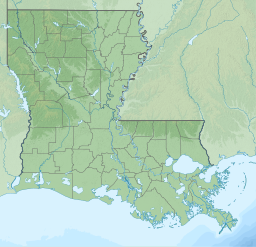Lake Pontchartrain
| Lake Pontchartrain | |
|---|---|
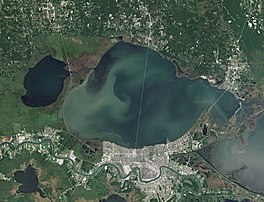 Sentinel-2 image | |
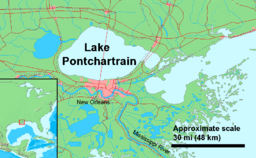 Map | |
| Location | Louisiana |
| Coordinates | 30°11′20″N 90°06′05″W / 30.18889°N 90.10139°W |
| Lake type | Estuary, saline |
| Basin countries | United States |
| Max. length | 40 mi (64 km) |
| Max. width | 24 mi (39 km) |
| Surface area | 630 sq mi (1630 km2) |
| Average depth | 12–14 ft (3.7–4.3 m) |
| Max. depth | 65 ft (20 m) |
| Surface elevation | 1 ft (0.30 m) |

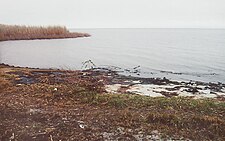
Lake Pontchartrain (/ˈpɒntʃətreɪn/ PON-chə-trayn;[1] French: Lac Pontchartrain) is an estuary located in southeastern Louisiana in the United States. It covers an area of 630 square miles (1,600 km2) with an average depth of 12 to 14 feet (3.7 to 4.3 m). Some shipping channels are kept deeper through dredging. It is roughly oval in shape, about 40 miles (64 km) from west to east and 24 miles (39 km) from south to north.
In descending order of area, the lake is located in parts of six Louisiana parishes: St. Tammany, Orleans, Jefferson, St. John the Baptist, St. Charles, and Tangipahoa. The water boundaries were defined in 1979 (see list of parishes in Louisiana).
The lake is crossed by the Lake Pontchartrain Causeway, the longest continuous bridge over water in the world.[2] A power line also crosses the lake. Its towers stand on caissons in Lake Pontchartrain, and its length can be used to visually demonstrate the curvature of the Earth.[3]
Toponymy
[edit]Lake Pontchartrain was named for Louis Phélypeaux, Comte de Pontchartrain. He was the French Minister of the Marine, Chancellor, and Controller-General of Finances during the reign of France's "Sun King", Louis XIV, for whom the colony of La Louisiane was named.[4]
The name Pontchartrain itself comes from the place in France where Phélypeaux's château was situated. It is thought that this name originates from it being where a bridge (French: pont) crossed the river Mauldre on the ancient route from Lutèce to Chartres (chartrain).[citation needed]
Lake Maurepas, directly west of Lake Pontchartrain, was named for Phélypeaux's son, the Comte de Maurepas, who was also a French statesman.
Description
[edit]Lake Pontchartrain is an estuary connected to the Gulf of Mexico via the Rigolets strait (known locally as "the Rigolets") and Chef Menteur Pass into Lake Borgne, another large lagoon, and therefore experiences small tidal changes. It receives fresh water from the Tangipahoa, Tchefuncte, Tickfaw, Amite, and Bogue Falaya rivers, and from Bayou Lacombe and Bayou Chinchuba. It is one of the largest wetlands along the Gulf Coast of North America.[5] It comprises more than 125,000 acres of wetland, including bottomland hardwoods and cypress swamps (although these have been severely degraded by past logging), along with a complex mixture of herbaceous wetlands including fresh, intermediate, and brackish marsh.[6] Lake Pontchartrain itself is part of the larger Pontchartrain Basin, a 10,000 square mile watershed that includes 16 Louisiana parishes and 4 Mississippi counties.[7] The Basin is one of the largest estuarine systems of the Gulf of Mexico. The Pontchartrain Basin includes Lake Pontchartrain and the drainage area of its tributary streams, Lake Maurepas and the drainage area of its tributaries, The Rigolets, Lake Borgne, the Biloxi Marsh and Chandeleur Sound.
Salinity in Lake Pontchartrain varies from negligible at the northern cusp west of Mandeville up to nearly half the salinity of seawater at its eastern bulge near Interstate 10. Lake Maurepas, a true freshwater lake, connects with Lake Pontchartrain on the west via Pass Manchac. The Industrial Canal connects the Mississippi River with the lake at New Orleans. Bonnet Carré Spillway diverts water from the Mississippi into the lake during times of river flooding.
History
[edit]The lake was formed 2,600 to 4,000 years ago as the evolving Mississippi River Delta formed its southern and eastern shorelines with alluvial deposits.[8] Human habitation of the region began at least 3,500 years ago. One recorded Indigenous name for the lake is Okwata ('wide water').[9]
Habitation increased rapidly with the arrival of Europeans; in 1699, French explorer Pierre Le Moyne d'Iberville renamed the Lake Pontchartrain after Louis Phélypeaux, comte de Pontchartrain.
In 1777, the great American naturalist, William Bartram, explored the north shore during a trip west.[10] In 1852, a railroad was constructed to link New Orleans to the north. Engines turned at Pass Manchac. However, the pilings were burned to the water line in the Civil War.[11]
During the early 20th century, the great cypress swamps of the area were heavily logged and many have not regrown.[12][13][self-published source]
After over 30 years of oil drilling had yielded just 12 million barrels of oil and condensate and 119 billion cubic feet of natural gas, and caused major pollution of the lake, the State Mineral Board enacted a moratorium on oil drilling. As of 2009, there were 4 active wells continuing prior leases, and 25 derelict wells.[14] According to the Louisiana Department of Environmental Quality (LDEQ), they and the US Coast Guard see at least one oil spill per day in Louisiana's wetlands.[14]: 6 Estuarine wetlands are among the highest on the Environmental sensitivity Index (ESI).[14]: 6
Conservation and restoration
[edit]Owing to past exploitation,[which?] the ecosystems of the lake have been placed under stress. Marshes, for example, are turning to open water, and cypress swamps are being killed by saltwater intrusion. However, brown pelicans and bald eagles, once scarce, were a common sight along the shores as of 2004.[15] A team of experts assembled by The Nature Conservancy assessed the situation in 2004 and identified seven target habitat types in particular need of conservation management: bottomland hardwood forest, cypress swamp, relict ridge woodland, fresh/intermediate marsh, brackish/salt marsh, lake open water, and littoral submersed aquatic vegetation. The bottomland hardwood forest and cypress swamp are suffering from a lack of freshwater input and sediment deposition owing to the levees upstream from the lake. In addition, bottomland hardwoods are being invaded by exotic species such as Chinese tallow, while freshwater marshes are being invaded by exotic species such as elephant's-ear.[5] The team identified four key animal species which could indicate the degree to which the system declines or improves. These were the rangia clam (representing lake bottom habitat), gulf sturgeon and paddlefish (representing fish communities), and the alligator snapping turtle (one of the largest freshwater turtles in the world, but in decline owing to over-harvesting).[5]
The future of the lake depends, in part, on restoring annual spring floods to the wetlands of the lake basin and controlling urban sprawl on the north shore. Selected species, like the paddlefish and alligator snapping turtle, would benefit from reduced harvesting. The lake could change considerably without such conservation planning. As of 2007, a few examples of future change included more cypress swamps converting to anthropogenic marsh or open water, Chinese tallow displacing native forests, and, with a warming climate, mangrove trees replacing brackish marsh.[16] Hence, the ecosystems of the lake now, and in the future, depend very much upon some basic decisions about human activities in the vicinity of the lake, and, even more so, human activity upstream along the Mississippi River.
As of 2006, the population in the region was over 1.5 million.[clarification needed] There have been many problems with the conservation management of forests and wetlands.[17][18] As of 1995, the United States Geological Survey was monitoring the environmental effects of shoreline erosion, loss of wetlands, pollution from urban areas and agriculture, saltwater intrusion from artificial waterways, dredging, basin subsidence and faulting, storms and sea level rise, and freshwater diversion from the Mississippi and other rivers.[19] With proper management of this lake and its wetlands, there is great potential to enhance the productivity of wetlands, and to maintain biological diversity to support an ecotourism industry that will diversify the economy.[13]
Northshore
[edit]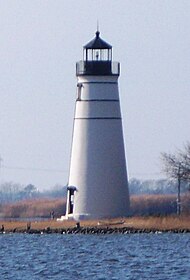
The area north of Lake Pontchartrain is known as the North Shore or the Northshore. It includes the cities of Mandeville, Covington, Abita Springs, Madisonville, Pearl River, Lacombe, and Slidell in St. Tammany Parish; Ponchatoula, Hammond, Amite, and Kentwood in Tangipahoa Parish; and Bogalusa and Franklinton in Washington Parish.
These three Northshore parishes are the eastern Florida Parishes. The landscape here is mostly uplands that were once dominated by long leaf pine savannas and interrupted by occasional large rivers. The savannas were maintained by regular fires caused by lightning; they produced the distinctive fauna and flora of this region.[13]
Lake Pontchartrain's south shore areas (dominated by New Orleans), instead of being designated by that name, are more likely to be referred to as either "East bank" or "West bank," depending upon their position with respect to the general north–south course of the Mississippi River. Lake Pontchartrain forms the northern boundary of the city of New Orleans, which is coterminous with Orleans Parish, and the northern boundary of its two largest suburbs, Metairie and Kenner; as well as forming the northern boundaries of Jefferson Parish and Saint Charles Parish, and much of the northern and eastern boundaries of Saint John the Baptist Parish.
New Orleans
[edit]New Orleans was established at a Native American portage between the Mississippi River and Lake Pontchartrain. The lake provides numerous recreational activities for people in New Orleans and is also home to the Southern Yacht Club. In the 1920s, the Industrial Canal in the eastern part of the city opened, providing a direct navigable water connection, with locks, between the Mississippi River and the lake. In the same decade, a project dredging new land from the lake shore behind a new concrete floodwall began; this would result in an expansion of the city into the former swamp between Metairie/Gentilly Ridges and the lakefront. The Lake Pontchartrain Causeway was constructed in the 1950s and 1960s, connecting New Orleans (by way of Metairie) with Mandeville, and bisecting the lake in a north-northeast line.
Hurricanes
[edit]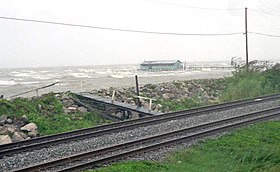
During hurricanes, a storm surge can build up in Lake Pontchartrain. Wind pushes water into the lake from the Gulf of Mexico as a hurricane approaches from the south, and from there it can spill into New Orleans.
A hurricane in 1947 flooded much of Metairie, much of which is slightly below sea level due to land subsidence after marshland was drained. After the storm, hurricane-protection levees were built along Lake Pontchartrain's south shore to protect New Orleans and nearby communities. A storm surge of 10 feet (3.0 m) from Hurricane Betsy overwhelmed some levees in eastern New Orleans in 1965, while a storm surge funneled in by the Mississippi River–Gulf Outlet Canal and a levee failure flooded most of the Lower 9th Ward. After this the levees encircling the city and outlying parishes were raised to heights of 14 to 23 feet (4.3 to 7.0 m). Due to cost concerns, the levees were built to protect against only a Category 3 hurricane; however, some of the levees initially withstood the Category 5 storm surge of Hurricane Katrina (August 2005), which only slowed to Category 3 winds within hours of landfall (due to a last-minute eyewall replacement cycle).
Experts using computer modeling at Louisiana State University after Hurricane Katrina have concluded that the levees were never topped but rather faulty design, inadequate construction, or some combination of the two were responsible for the flooding of most of New Orleans. Some canal walls leaked underneath because the wall foundations were not deep enough in peat-subsoil to withstand the pressure of higher water.[20]
Funding
[edit]Congress failed to fully fund an upgrade requested during the 1990s by the Army Corps of Engineers, and funding was cut in 2003–04 despite a 2001 study by the Federal Emergency Management Agency warning that a hurricane in New Orleans was one of the country's three most likely disasters.[21] Raising and reinforcing the levees to resist a Category 5 hurricane might take 25 years to complete.[22] Some estimates place the cost at $25 billion.
Hurricane Katrina
[edit]

When Hurricane Katrina reached Category 5 in 2005, some experts predicted that the levee system might fail completely if the storm passed close to the city. Although Katrina weakened to a Category 3 before making landfall on August 29 (with only Category 1-2 strength winds in New Orleans on the weaker side of the eye of the hurricane), the outlying New Orleans East area along south Lake Pontchartrain was in the eyewall with winds, preceding the eye, nearly as strong as those experienced in Bay St. Louis, Mississippi. Canals near Chalmette began leaking at 8 am,[citation needed] and some levees/canals, designed to withstand Category 3 storms, suffered multiple breaks the following day (see Effects of Hurricane Katrina in New Orleans), flooding 80% of the city.
The walls of the Industrial Canal were breached by storm surge via the Mississippi River Gulf Outlet, while the 17th Street Canal and London Avenue Canal experienced catastrophic breaches, even though water levels never topped their flood walls. Louisiana State University experts presented evidence that some of these structures might have had design flaws or faulty construction.[23]
There are indications that the soft earth and peat underlying canal walls may have given way. In the weeks before Katrina, tests of salinity in seepage pools near canals showed them to be lake water, not fresh water from broken mains. The 5.5-mile-long (8.9 km) I-10 Twin Span Bridge heading northeast between New Orleans and Slidell was destroyed. The shorter Fort Pike Bridge crossing the outlet to Lake Borgne remained intact.
Much of the northern sector of the suburban areas of Metairie and Kenner was flooded with up to 2 to 3 feet (0.6 to 0.9 m) of water. In this area, flooding was not the result of levee overtopping but was due to a decision by the governmental administration of Jefferson Parish to abandon the levee-aligned drainage pumping stations.[24] This resulted in the reverse flow of lake water through the pumping stations into drainage canals which subsequently overflowed, causing extensive flooding of the area between I-10 and the lakefront. When the pump operators were returned to their stations, water was drained out of Metairie and Kenner in less than a day.[citation needed]
On September 5, 2005, the Army Corps of Engineers started to fix levee breaches by dropping huge sandbags from Chinook helicopters. The London Avenue Canal and Industrial Canal were blocked at the lake as permanent repairs started. On September 6, the Corps began pumping flood water back into the lake after seven days in the streets of New Orleans. Because it was fouled with dead animals, sewage, heavy metals, petrochemicals, and other dangerous substances, the Army Corps worked with the U.S. Environmental Protection Agency and Louisiana Department of Environmental Quality (LDEQ) to avoid major contamination and eutrophication of the lake.[25]
Aerial photography suggests that 25 billion US gallons (95,000,000 m3) of water covered New Orleans as of September 2, which equals about 2% of Lake Pontchartrain's volume.[citation needed] Due to a lack of electric power, the city was unable to treat the water before pumping it into the lake. It is unclear how long the pollution will persist and what its environmental damage to the lake will be, or what the long-term health effects will be in the city from mold and other contamination.
On September 24, 2005, Hurricane Rita did not breach the temporary repairs in the main part of the city, but the repair on the Industrial Canal wall in the Lower 9th Ward was breached, allowing about 2 feet (0.6 m) of water back into that neighborhood.
Notable deaths
[edit]- Eastern Air Lines Flight 304 crashed into the lake on February 25, 1964, resulting in the deaths of 51 passengers and 7 crew.
- On June 16, 1964, a Trailways bus plunged off the Lake Pontchartrain Causeway into Lake Pontchartrain, killing 6.[citation needed]
- On December 31, 1967, a chartered plane crashed into Lake Pontchartrain, killing 5 servicemen and the pilot.[citation needed]
- On September 15, 1978, six-year-old Benjamin Daly, along with the pilot, died when a private plane his parents had chartered crashed into the lake. His parents survived.[citation needed]
- On February 23, 1980, a twin-engine plane crashed into Lake Pontchartrain, killing 7.[citation needed]
- On January 15, 1981, a Piper PA-23 flying in heavy fog crashed into Lake Pontchartrain while on final approach to New Orleans Lakefront Airport,[26] killing the plane's owner and pilot Joyce W. Hornady, the 73-year-old CEO of Hornady Manufacturing Company, and two other company employees Edward A. Heers, a 34-year-old engineer, and James W. Garber, a 29-year-old customer service manager.[27][28] All three men were due to attend and represent their company in the 1981 SHOT Show in New Orleans.[29]
- In 1986, a decomposing woman's body was found by two fishermen. The cause of death was homicide by asphyxia. She was not identified and no leads were ever identified in the case.[30]
- New England Patriots defensive end, New Orleans native, and former LSU star Marquise Hill was found dead in Lake Pontchartrain on May 28, 2007.[31]
- A U.S. Navy T-34 training plane crashed into the lake on January 23, 2010, after a routine training mission. The instructor, LT Clinton Wermers, was found dead at 0100 on January 27, 2010. The student pilot was rescued about two hours after the crash.[32][33]
See also
[edit]- Lake Pontchartrain Causeway
- Bonnet Carré Spillway
- Tammany Trace Rail Trail
- Louisiana's 1st congressional district
- List of lakes of the United States
- "The Lakes of Pontchartrain"
- Lombard Plantation
References
[edit]- ^ "Oil from Gulf spill seeps into New Orleans' Lake Pontchartrain". The Associated Press. July 6, 2010.
Pontchartrain (pronounced PAHN-chuh-trayn)
[Respelled "ponch-a-train" in other sources] - ^ "Longest bridge over water (continuous)". Guinness World Records. Retrieved 2019-02-01.
- ^ "Power lines over Lake Pontchartrain elegantly demonstrate the curvature of Earth". ZME Science. 2017-07-27. Retrieved 2021-04-05.
- ^ "Lake Pontchartrain Historical Marker". Louisiana Department of Culture, Recreation & Tourism.
- ^ a b c Keddy, P.A., D. Campbell, T. McFalls, G. Shaffer, R. Moreau, C. Dranguet, and R. Heleniak. 2007. The wetlands of lakes Pontchartrain and Maurepas: past, present, and future. Environmental Reviews 15: 1- 35.
- ^ Keddy, P.A., D. Campbell, T. McFalls, G. Shaffer, R. Moreau, C. Dranguet, and R. Heleniak. 2007. The wetlands of lakes Pontchartrain and Maurepas: past, present, and future. Environmental Reviews 15: 1- 35. Table 2.
- ^ "Basin History". Pontchartrain Conservancy. Retrieved 2023-07-09.
- ^ "Environmental Atlas of the Lake Pontchartrain Basin". USGS Coastal and Marine Geology Program. May 14, 2002. Retrieved 2006-06-15.
- ^ "HISTORY OF THE PONTCHARTRAIN BASIN". scienceforourcoast.org. Retrieved 11 October 2023.
- ^ Keddy, P.A., D. Campbell, T. McFalls, G. Shaffer, R. Moreau, C. Dranguet, and R. Heleniak. 2007. The wetlands of lakes Pontchartrain and Maurepas: past, present and future. Environmental Reviews 15: 1-35.
- ^ Perrin, J.M. 2000. Home Town Ponchatoula. A Community History of Ponchatoula, Louisiana. Self-published. Ponchatoula, Louisiana.
- ^ Norgress, R. E. (1947). The history of the cypress lumber industry in Louisiana. Louisiana Historical Quarterly 30: 979–1059.
- ^ a b c Keddy, P.A. 2008. Water, Earth, Fire: Louisiana's Natural Heritage. Xlibris, Philadelphia. 229 p.[self-published source]
- ^ a b c "Moratorium on Oil and Gas Leasing In Lake Pontchartrain: An Analysis" (PDF). The Lake Pontchartrain Basin Foundation. 2010.
- ^ Maygarden, D., and others. 2004. Conservation Area Plan for the Lake Pontchartrain Estuary. The Nature Conservancy, LA.
- ^ Keddy, P.A., D. Campbell, T. McFalls, G. Shaffer, R. Moreau, C. Dranguet, and R. Heleniak. 2007. The Wetlands of Lakes Pontchartrain and Maurepas: past, present, and future. Environmental Reviews 15: 1- 35. Fig. 21
- ^ Houck, O. 2006. Can we save New Orleans? Tulane Environmental Law Journal 19: 1–68.
- ^ Keddy, P.A. 2010. Wetland Ecology: Principles and Conservation (2nd edition). Cambridge University Press, Cambridge, UK. 497 p.
- ^ With "The Lake Pontchartrain Basin: Louisiana's Troubled Urban Estuary". U.S. Geological Survey. November 3, 1995. Archived from the original on June 3, 2006. Retrieved 2006-06-15.
- ^ Grunwall, Michael; Glasser, Susan B. (September 21, 2005). "Experts Say Faulty Levees Caused Much of Flooding". washingtonpost.com. Retrieved 2006-06-15.
- ^ Blumenthal, Sidney (August 31, 2005). "No one can say they didn't see it coming". Salon.com. Retrieved 2006-06-15.
- ^ Handwerk, Brian (September 2, 2005). "New Orleans Levees Not Built for Worst Case Events". National Geographic News. Archived from the original on September 5, 2005.
- ^ Grunwald, Michael; Glasser, Susan B. (September 21, 2005). "Experts Say Faulty Levees Caused Much of Flooding". washingtonpost.com. Retrieved 2006-06-15.
- ^ Broussard says he didn't send pump operators away - Kenner Bulletin - NOLA.com Archived 2008-04-29 at the Wayback Machine.
- ^ USACE (September 2005). "Quick, coordinated efforts reduce environmental impact on Lake Pontchartrain". usace.army.mil. Archived from the original on May 13, 2007. Retrieved 2007-07-03.
- ^ "A twin-engine plane carrying three people on a flight from Nebraska crashed into Lake Pontchartrain in heavy fog Thursday while on approach to New Orleans Lakefront Airport". www.upi.com/archives. January 15, 1981. Retrieved October 18, 2018.
- ^ "Plane crashes into lake in heavy fog". www.upi.com/archives. 1981-01-16.
- ^ "Three Killed in Crash of a Plane In Lake Near New Orleans Field". New York Times. 1981-01-17.
- ^ "The Hornady Heritage and Vision".
- ^ "Body Discovered--Two Decade Mystery Begins". Sex-offenders.info. Retrieved 27 January 2010.[permanent dead link]
- ^ Simpson, April; Levenson, Michael (May 29, 2007). "Patriot Hill is found dead". boston.com. Retrieved 27 January 2010.
- ^ "Navy pilot presumed dead after crash in Lake Pontchartrain". cnn.com. January 25, 2010. Retrieved 25 January 2010.
- ^ Navy pilot's body found in Lake Pontchartrain, The Times-Picayune, January 27, 2010
Further reading
[edit]- Lake Pontchartrain, 2007, ISBN 978-0-7385-4392-5
External links
[edit]- Lake Pontchartrain Visitors Guide
- Lake Pontchartrain Basin Foundation
- United States Geological Survey Lake Pontchartrain Fact Sheet
- Real-time water data for Lake Pontchartrain
- New Orleans history of the lake
- Lake Pontchartrain Basin Maritime Museum
- USGS Environmental Atlas of Lake Pontchartrain
- New Orleans District Water Management
- Washington Post article alleging levee faults, 21 September 2005
- National Geographic article about the levees, 2 September 2005
- Salon article about disaster predictions, 31 August 2005
- U.S. Geological Survey article about the Lake Pontchartrain Basin, 3 November 1995
- BBC article about environmental effects on the lake after the flooding of New Orleans, 8 September 2005
- Lake Pontchartrain
- Estuaries of Louisiana
- Bodies of water of Jefferson Parish, Louisiana
- Bodies of water of Orleans Parish, Louisiana
- Bodies of water of St. Charles Parish, Louisiana
- Bodies of water of St. John the Baptist Parish, Louisiana
- Bodies of water of St. Tammany Parish, Louisiana
- Bodies of water of Tangipahoa Parish, Louisiana
- Lagoons of Louisiana
- Tourist attractions in Jefferson Parish, Louisiana
- Tourist attractions in New Orleans
- Tourist attractions in St. Charles Parish, Louisiana
- Tourist attractions in St. John the Baptist Parish, Louisiana
- Tourist attractions in St. Tammany Parish, Louisiana
- Tourist attractions in Tangipahoa Parish, Louisiana
- Oil fields of the United States

